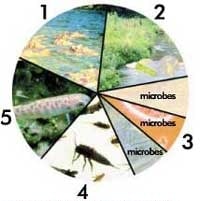The Rockefeller Grant
In Stroud Water Research Center’s early years, most people still thought of rivers as conduits that transported things—from ships to sewage—to the sea. With Lake Erie slowly suffocating in its own pollution, the plight of lakes seemed a far more urgent issue in those days.
Rachel Carson was an early and often lonely voice decrying the assault on rural waterways in Silent Spring, her 1962 environmental classic. In a chapter on “Rivers of Death” she described the decimation of fish populations from DDT pesticide programs meant to protect commercial forests. In a remarkably short time, the DDT wiped out a river’s food chain, and the stream died.

Carson evoked, as few others had, the unseen life of a stream: “Before the spraying, there had been a rich assortment of water life that forms the food of salmon and trout — caddisfly larvae, living in loosely fitting protective cases of leaves, stems or gravel cemented together with saliva, stonefly nymphs clinging to rocks in the swirling currents, and the worm-like larvae of black flies edging the stones under riffles or where the stream spills over steeply slanting rocks.”
She popularized what Ruth Patrick’s team had demonstrated on the Conestoga — that a river is an interrelated biological system in which the health of each part depends on the vitality of all the others.
By the 1960s, it was clear that our rivers were in trouble. Massive weeds clogged once-navigable waterways. The water in many streams had become too polluted to swim in, let alone drink. And on June 22, 1969, Cleveland’s Cuyahoga River caught fire, the flames leaping five stories into the air.
That same year the Stroud Center received a five-year grant from the Rockefeller Foundation to study the White Clay watershed. Faced with a new sense of urgency symbolized by the black smoke over the Cuyahoga River, Stroud scientists set out to learn all they could about how a stream works.
Following the trail that Patrick had blazed on the Conestoga River, an interdisciplinary team set out to scrutinize the watershed. Some biologists studied the production of algae which compose one base of the food web, while others analyzed how bacteria and fungi break down leaf litter. Entomologists examined insect groups, discovering that species replacement enables a stream to maintain its energy balance throughout the year. A chemist investigated the influence of geology, land use, and rain storms on the chemical composition of the water.
The research did not stop at the banks. Looking beyond to the entire watershed, the scientists began to measure the impact of activities outside the stream itself — both natural factors, such as falling leaves and changing sunlight, and human actions, ranging from farming practices and deforestation to industrial discharge and suburban lawns.
As a result of their massive sets of data, Stroud Center scientists expanded the knowledge of how biological communities interact in a stream and how they react to stress from both natural disturbances and human activities. At the close of the grant period they had painted an unprecedented portrait of a watershed.
